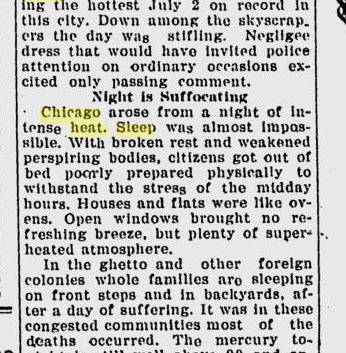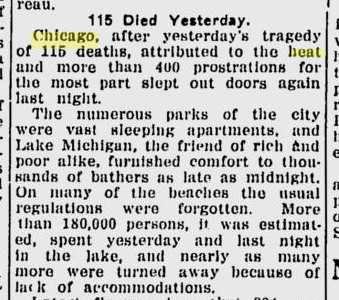Georeactor Blog
RSS FeedA World Ending in Fire, Part 2
Finished this book in the last leg of my trip from Denver to Chicago. I also did deep dives into historic heat waves and social media.
Heat Wave: A Social Autopsy of Disaster in Chicago (Eric Klinenberg, 2002; 2015 edition)
Thirty years ago, 700 Chicagoans died within a few days during a severe heat wave. Though then-Mayor Daley raised doubts about the statistics, this month Mayor Johnson attended a memorial in the Austin neighborhood.
The earliest version of this text that I could find was a sociology journal article "Denaturalizing Disaster: A Social Autopsy of the 1995 Chicago Heat Wave". That work became Klinenberg's PhD thesis, and this book in 2002. After the author became a professor at NYU, Hurricane Sandy and growing alarm around climate change made this book all the more relevant for its 2015 edition. MSNBC's Chris Hayes provided a blurb.
Another decade later this book has found a niche in progressive politics, climate activism, urbanism, and Chicago history. When we were preparing for a string of hot days this summer, Heat Wave was all the rage on my BlueSky feed.
There are climate doom books: The Uninhabitable Earth (2019), The Ministry for the Future (2020), The Heat Will Kill You First (2023). You can tell that someone reads those when they drop 'wet bulb temperature'. But this is a history, grounded in what killer heat looks like in an American city. The author did an excellent job interviewing seniors, journalists, the medical examiner, police, etc. to figure out how this disaster progressed, and why it became a non-event in people's memory.
Some things which I learned:
-
Seniors, particularly men and residents of SROs, were at the highest risk if they were socially isolated. The county could not find next-of-kin for many victims.
At first glance the city's "unique weather event" explanation is more digestible than this "social autopsy" but what we're opening up here is information beyond race, age, and poverty. If you can walk in the neighborhood, your building has a common area with AC, or you can call a friend to get a ride to the movies, yes that's public health! - Isolation often comes from a fear of crime, and reinforces that fear, and sometimes it was a valid fear (empty lots attracting drug dealers, recovering addicts placed in senior/disabled housing). Many seniors would not answer their doors.
- Chicago did not ramp up an emergency response in time to address the heat wave. This is maybe related to officials vacationing over the weekend, and not understanding that a heat wave could be significant until it was a media event.
- Opening up fire hydrants means a loss of water pressure in buildings. No water and sometimes no power for AC, intensifies problems. In NYC you can request a spray cap for your hydrant. Klinenberg refers to this cap, but currently I found only an application to use hydrant water for festivals or urban gardens.
- Death rates were particularly high in Black neighborhoods and low in Latino neighborhoods. Despite hearing theories about biology or culture, Klinenberg has a lot to say about the geography of neighborhoods (channeling Jane Jacobs), and multi-generational households. I feel like the neighborhood descriptions often reduce to streets with dense retail and less crime, and multi-generational households are a culture thing, but OK.
- I thought it was interesting to follow the weekend shift at the Tribune realizing that they were in the middle of a newsworthy crisis, even though reporting works totally differently in 2025.
By the time of the book's publication, Klinenberg could look at the responses to a heat wave in 1999, where the city executed their new information campaign and response plan. A hundred people died, but crucially the new policies showed that a limited, unprepared response was what made 1995 so deadly.
Summer Nights 🎵, a timeline
Major mortality from extreme heat in the U.S. before air conditioning used to be just… normal. https://bsky.app/profile/faineg.bsky.social/post/3ltuacvpnqs23
Earlier in the 20th century, Chicagoans responded to heat waves by sleeping outside en masse in parks and along the lake shore. Klinenberg relates a story of two men attempting to sleep outdoors in 1995 and giving up due to 'bugs, beggars, and police'.
When talking about heat waves today, Midwest news outlets love to find photos of well-dressed park sleepers. I put together a mini timeline.
Chicago, 1911

NYC, 1911: https://www.history.com/articles/heat-wave-1911-weather-insane
Chicago, 1916. "Prostrations" is heat exhaustion.

"We'd sleep out in the open; in a way it was kind of fun," she says. If friends and neighbors were sharing the same grassy venue, socializing among the adults and horseplay among the kids sometimes derailed the quest for serious shut-eye. Conversely, snoozing in the dark among a park full of strangers produced no nightmares, she says. "In those days, there weren't any problems of people bothering you. Detroit was a different place back then."
Belle Isle was the nocturnal refuge of choice for a small army of sleepless Detroiters carrying cots, hammocks, and blankets […]
Sleeping on a fire escape in NYC, 1938: https://www.metmuseum.org/art/collection/search/263656
Family lore: my grandfather was sleeping on his porch when he was woken up by the Trinity test.
Comments on a Facebook thread:
My mom told me it was common in the 40s to see people sleeping in the parks with their clean clothes neatly folded next to them next to wind up alarm clock so they could get up on time to work the next day.
My mom and family and friends used to go to Lincoln Park late 1940s, early 1950s.
Lived in a 2-flat with no air conditioning. Dad got home at 1:00Am from work, and would sleep in the reclining sun chair out in front….other neighbors too. Not any more!
My parents went to the Indiana dunes for the weekend & slept out on the dunes in the early '50
We used to go & sleep on the beach. Usually 12 street beach or North Av. There were always lots of people there too.
We in a 2nd floor apartment & sometimes slept on our back porch….just put some pots & pans on the steps in case someone walked up the stairs. Never had any problems.
Yep in the 60s we went down to the lake and slept
I remember people doing that, but my mother said you're not doing it cuz they're nuts
Via Bluesky:
My mom grew up on the Mississippi and big stories of every summer heat wave they'd sleep in the yard and one year it was so bad, half the town was sleeping in the park
The latest park sleepers photo in the book is from 1964. When did Chicagoans move away from lake and park camping? ChatGPT suggested that I look into the summer of 1966. Via Wikipedia
The "hydrant riot" broke out in Chicago after the city's Fire Commissioner, Robert J. Quinn, ordered an immediate shutdown of all fire hydrants that had been opened on a day where the temperatures had topped 100 °F […] There were four pools on the city's predominantly African American west side, but all four "were located in all-white, violence-prone neighborhoods".
After several days of looting, destruction, and protests led by Dr. Martin Luther King Jr., Mayor Richard J. Daley would relent, ordering that police provide safe passage and protection for black residents to use the white pools, as well as trucking in portable pools and allowing the use of the hydrants during the heat spell
I do wonder though, particularly on the "they're nuts" comment, if sleeping in the park was the refuge for only the most desperate boarders who did not have a porch, fire escape, or window. The 1911 article suggests "the ghetto and other foreign colonies". In photos you see a lot of men and virtually no families.
Comparisons to Covid
Multiple scenes and interviews bring to mind the Covid pandemic and "dying with Covid". There is a similar analysis of excess deaths, which reveal that Milwaukee suffered a Chicago-level heat disaster at the same time.
Last year Klinenberg wrote an op-ed for the New York Times "We Were Wrong About What Happened to America in 2020" and on the academic side published "On Our Own: Social Distance, Physical Loneliness, and Structural Isolation in the COVID-19 Pandemic".
Lessons from Crowd Crush
I was waiting for the inter-terminal train at the Denver airport when there was an extended delay. The room quickly filled as more people came down escalators. Having read about crowd crushes, I began thinking about exits, when do I call the airport? Later a woman on the train told me she'd texted her company to stop people at security. It was affirming to talk to someone else who saw it was a bad situation.
Ten years ago, crowd crush events were commonly called 'stampedes' and fatalities described as 'trampled'. In 2015, over two thousand pilgrims died during the Hajj. The confusion around what actually happened, and the scale of disaster changed media coverage. Terms like crowd crush and crowd collapse began to appear in US media. After the Itaewon crowd crush in 2022, editors mostly removed 'stampede' from this and other Wikipedia articles. Changing language removes blame from a panicked crowd, and helps people understand the risk.
There's some remarkable overlap with this and the 'heat wave' deaths. Lacking an intuition of the problem, people would ask: what made this one event turn deadly? Can we perceive and understand this well enough to prevent it? After Itaewon, Seoul and Tokyo have banned their largest gatherings, rather than traffic planning or reacting in the moment. Saudi Arabia has increased the number of surveillance cameras and trialed smart wristbands in Mecca.
During last year's Hajj, over 1,300 pilgrims died from extreme heat.
Climate Historicity and Social Media
Climate Integrity produced a few social media videos for the anniversary of the 2021 Pacific NW heat wave
- https://bsky.app/profile/climateintegrity.org/post/3lsourvr7lc2l
- https://bsky.app/profile/climateintegrity.org/post/3lsjiw3zwgk26
I recently discovered the heat_prep subreddit, which is actually rather critical of Ministry for the Future. They have AMAs with heat experts. When reading through more typical posts, the two common threads are fighting misconceptions about water, sweat, and temperature; and people whose jobs require them to be outside in the heat.
Previous Reads / Notes
I watched the new 3-hour Hunter Biden interview, and he talks a lot about community. Whatever his deal is, dude has heard a lot about addiction and recovery. After reading about public health here, and civil defense in the WW3 book, it's interesting that this also comes back to community.
Politically Hunter Biden has grievances with Pelosi, Schumer, Clooney, and "Pod Save America" for making Joe withdraw from the race. He wants to avoid speaking ill of Harris, Walz, or Obama, so he claims that Pelosi wanted an open convention for some other unknown candidate. (?)
Colbert's first Late Show episode has a few surprises.
Apparently late night ad revenue has halved since 2018. Maybe that and political pressure really can end the 'late night talk how' format? I was trying to think of other shows which do upcoming movie promotion and the internet reminded me of SNL and Hot Ones?
Other networks can set up a soft landing for Colbert, and I would point to his animation projects (a strong pick to break out of a daily on-camera role). 2026 is good timing to show up and wave at a few midterm campaigns, maybe he narrates a documentary, maybe he can do a few travel shows a year like Conan O'Brien.
1998 Japanese movie After Life was good, a little over-the-top, but I liked how they incorporated real stories. M3gan 2.0 got chopped up in editing but absolutely shocked me with some real computer history. I'm a Virgo was a good dose of surreal.
Discussion of informal + texting speak in Indonesian language: https://www.youtube.com/watch?v=spBaB9c37n0&t=10m30s